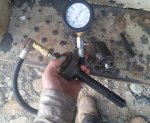Quetzal
New member
- 6
- 0
- 0
- Location
- Middle of Nowhere / AZ
I haven't been able to find a photo of one of these, just mumblings about being able to make one from butchering an old injector. I think the first attempt (in the background, laying on the step) was cut too short and maybe not sealing well? Best tests were hitting 140 psi, with most somewhere between 50psi and nearly 0. Correct me if I'm wrong, but if those readings are accurate, it would not run and drive, yeah? It runs and drives, just sounds like not all cylinders are participating and smells like unburned diesel. Lots of white smoke. Oil on the dipstick does not look like chocolate milk, but it has been a bit thirsty for coolant (we have been doing some hill climbs and long days though)
Tried making another one and leaving it long, but it was reading flat 0. I know I have to hack more off or remove some guts, since pressure isn't making it up to the gauge, I am just curious how or where I should hack it. Has anyone made a functional one?
It seems like you should be able to unscrew the bottom and open it to leave it long and pull the guts, but vice grips aren't doing it. Is there some secret here?

Tried making another one and leaving it long, but it was reading flat 0. I know I have to hack more off or remove some guts, since pressure isn't making it up to the gauge, I am just curious how or where I should hack it. Has anyone made a functional one?
It seems like you should be able to unscrew the bottom and open it to leave it long and pull the guts, but vice grips aren't doing it. Is there some secret here?



